Super Thursday, as Ed Winkleman jokingly called it, turned out to be a huge disappointment. Fair warning before I continue: I am clinically depressed. You may freely roll your eyes at that statement. Just in case you care, though, I've written up a short screed on What Depression Means to Me, so if you feel like you're up for it, go read that. If not, just take away this: I was cranky as all hell on Thursday and maybe that colors the following comments, opinions, and general unpleasantry. It doesn't help that few things deepen my bad moods as much as standing around in a noisy room which is too warm and crowded with people who are too hip for me. And that pretty much defines Super Thursday.
I've been going to Chelsea galleries regularly now for the last nine months or so and as busy and insane as it had ever gotten, I have never seen it like it was Super Thursday, September 7, 2006. Whether this was especially crazy compared to past openings of the New York City art world, I do not know. It wasn't Herald Square around Christmas -- which is pretty much my high setting for crowded New York stupidity, since I've never come in for New Year's Eve -- but it was, nevertheless, nuts.
You'd think, then, that the galleries of Chelsea would be putting out their absolute best of the season. Well, I can imagine a few possibilities here: First, galleries are actually saving their best for later in the season when the hordes of art gawkers will have died down, leaving room for those more serious; second, galleries really do think this is their best, and this is going to be the worst year for art on record; third, I chose all the bad shows and missed all the really good ones; or, finally, I have no taste whatsoever and everything I saw was incredible, but I'm such a philistine I can't tell.
We're going to set aside the fourth possibility as being beyond discussion.
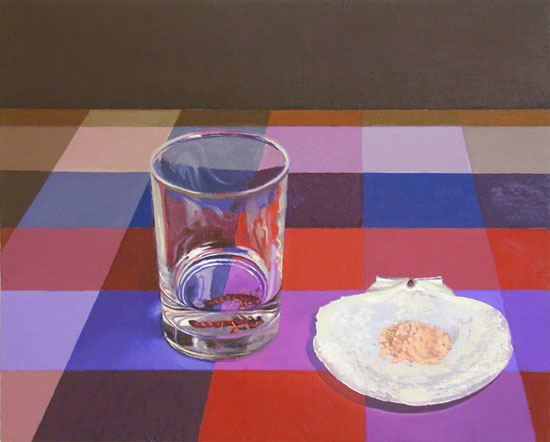 My evening began with parking on West 27th Street outside of my favorite gallery and walking down to 18th and Tenth to start in Bellwether Gallery with Everest Hall's show Axis Mundi. I mentioned on my Plan Ahead sub-blog that I wanted to see Everest's work because the signature painting of the show had a bumblebee in it, and another one of his paintings had a glass in it, and in subject and style I'd been meaning to paint a painting showing a bee trapped in an overturned glass, sitting on a wooden desk, which would have fit precisely in Everest's exhibit. I am now glad I never bothered to paint that painting, both because Everest has, in essence, painted it already, and also because I now see how shallow it would have been. Everest's paintings are competent. They have a good realism to them. They look good. They'd make excellent decorations on someone's wall and are much nicer than most of what you see in hotel hallways.
My evening began with parking on West 27th Street outside of my favorite gallery and walking down to 18th and Tenth to start in Bellwether Gallery with Everest Hall's show Axis Mundi. I mentioned on my Plan Ahead sub-blog that I wanted to see Everest's work because the signature painting of the show had a bumblebee in it, and another one of his paintings had a glass in it, and in subject and style I'd been meaning to paint a painting showing a bee trapped in an overturned glass, sitting on a wooden desk, which would have fit precisely in Everest's exhibit. I am now glad I never bothered to paint that painting, both because Everest has, in essence, painted it already, and also because I now see how shallow it would have been. Everest's paintings are competent. They have a good realism to them. They look good. They'd make excellent decorations on someone's wall and are much nicer than most of what you see in hotel hallways.
Um. I don't want to damn Everest with faint praise like that, but there you go.
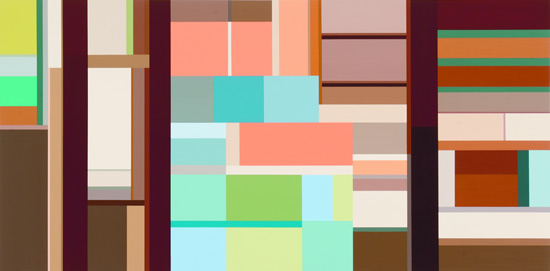 Karen Dow was also showing. I immediately thought that here was what Piet Mondrian would paint if someone had switched his palette, possibly with a "Miami Vice" coloring set. These are the kind of paintings which mystify me: Clearly there's no way anyone could possibly make it through an MFA program -- at Yale, no less -- without knowing the work of painters like Mondrian, and yet here they are, not really doing anything much more than was already done. Now, do I believe that Mondrian exhausted every possibility in this kind of rectilinear abstract painting? No. I believe, as something of an article of faith, that no artist can possibly answer all the questions their work asks. Do I believe that Karen is answering new questions left by Mondrian? No, I do not. I even spent some time calling up what I could remember of mathematics and proportions, trying to see, is this the Golden Ratio here? Is she exploring geometric concepts? Granted that I don't have all this at my fingertips all the time; still, I didn't see it.
Karen Dow was also showing. I immediately thought that here was what Piet Mondrian would paint if someone had switched his palette, possibly with a "Miami Vice" coloring set. These are the kind of paintings which mystify me: Clearly there's no way anyone could possibly make it through an MFA program -- at Yale, no less -- without knowing the work of painters like Mondrian, and yet here they are, not really doing anything much more than was already done. Now, do I believe that Mondrian exhausted every possibility in this kind of rectilinear abstract painting? No. I believe, as something of an article of faith, that no artist can possibly answer all the questions their work asks. Do I believe that Karen is answering new questions left by Mondrian? No, I do not. I even spent some time calling up what I could remember of mathematics and proportions, trying to see, is this the Golden Ratio here? Is she exploring geometric concepts? Granted that I don't have all this at my fingertips all the time; still, I didn't see it.
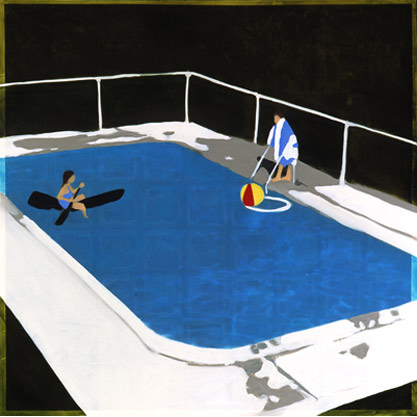 The next disappointment was Isca Greenfield-Sanders at Goff + Rosenthal. Isca's paintings actually look much, much better online than they do in person. In person they're made of overlapping squares of some material, maybe photos, which have been painted over. They look almost precisely like overexposed, unfocused, tinted photos. Photos of nothing much interesting. The title of this one says it all: Swimming Pool with Ball. Never mind the people in the painting. They're props. The inanimate objects are the subject of the painting. And who cares about a pool? Each painting is like an image from a glossy brochure for disaffected vacationers. Maybe that's supposed to mean something, but all I took it to mean was, "I am Isca Greenfield-Sanders, and I will be successful no matter what you think."
The next disappointment was Isca Greenfield-Sanders at Goff + Rosenthal. Isca's paintings actually look much, much better online than they do in person. In person they're made of overlapping squares of some material, maybe photos, which have been painted over. They look almost precisely like overexposed, unfocused, tinted photos. Photos of nothing much interesting. The title of this one says it all: Swimming Pool with Ball. Never mind the people in the painting. They're props. The inanimate objects are the subject of the painting. And who cares about a pool? Each painting is like an image from a glossy brochure for disaffected vacationers. Maybe that's supposed to mean something, but all I took it to mean was, "I am Isca Greenfield-Sanders, and I will be successful no matter what you think."
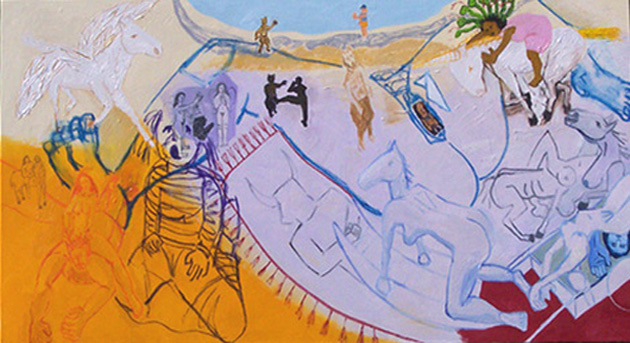 Next up was Nicole Maynard at the Bowery Gallery. I must admit to some naivete here. I can't tell one type of gallery from another. I haven't been involved in gallery-hopping long enough to know much of anything regarding the reputations of any galleries. I know there are vanity galleries; I know there are co-operative galleries; and then there are regular galleries. I don't who is who, exactly, and I don't always do research before I visit a gallery. If I like the work I see online, I go. If someone recommends a show or invites me, I may go.
Next up was Nicole Maynard at the Bowery Gallery. I must admit to some naivete here. I can't tell one type of gallery from another. I haven't been involved in gallery-hopping long enough to know much of anything regarding the reputations of any galleries. I know there are vanity galleries; I know there are co-operative galleries; and then there are regular galleries. I don't who is who, exactly, and I don't always do research before I visit a gallery. If I like the work I see online, I go. If someone recommends a show or invites me, I may go.
The Bowery Gallery is apparently a co-operative gallery. That's better than a vanity gallery but I still have some reservations about it. Still, Nicole invited me via e-mail. Not personally, but my address was on her list somehow, so, you know, I figured I'd try to go.
I can't say I was disappointed because I wasn't really expecting anything in particular from Nicole. Her paintings online didn't look great, but I don't like judging entirely by reproductions. I tried to keep an open mind.
Nicole Maynard's paintings look like someone ate Picasso, Matisse, and Gauguin, and failed to fully digest them. I'm not a huge fan of any of those artists when they were in their paint-like-unto-a-child phases -- I'm not sure Gauguin had any other phase -- so I may not be the right person to look at this kind of thing. But honestly Nicole even had a painting she should have titled "My Guernica." Minotaurs are having sex with horse-headed ladies. Topless native beauties are standing amid fruit. And so on. All painted with technique to make a Fauvist stammer. I just don't understand why we're rehashing this stuff. It's not necessary or interesting.
I was so disconsolate after that show and having to thread my way through the masses of people in the vicinity (23rd Street was especially irritating) I actually forgot to stop to see Mary Henderson at Lyons Wier • Ortt. I therefore ended up at Lucas Schoormans seeing Maki Tamura.
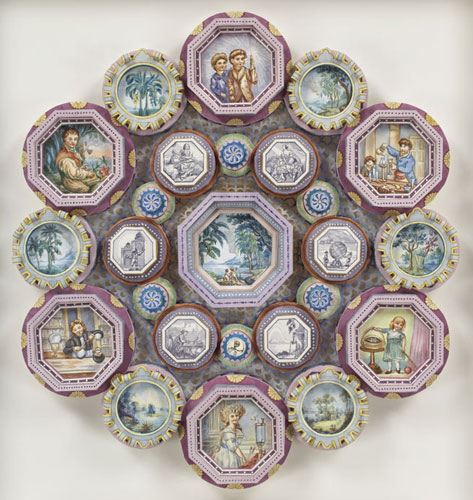 Once again I found myself confused by craft. Much like when I saw Julie Allen, I simply could not wrap my brain around this work. Maki Tamura's works are crowds of carefully folded paper, glued together and painted, with tiny, detailed scenes or creatures or decorative elements. Each thing -- is it a painting, a sculpture, a drawing (it's on paper, after all)? -- each thing is like a strange Victorian curio cabinet, filled with knick-knacks from some overseas cruise. The attention to detail and the craft involved in building these things is clear. And yet I have no opinion on them. They're just there. They connect with nothing in my experience. I think I just totally lack the background to appreciate Maki's work as anything other than saying, yes, it is here. It's not funny, or kitschy, or sick, or nostalgic, or cute; it's not neat, fun, bold, exciting, ugly, stupid, or worthless. It is what it is.
Once again I found myself confused by craft. Much like when I saw Julie Allen, I simply could not wrap my brain around this work. Maki Tamura's works are crowds of carefully folded paper, glued together and painted, with tiny, detailed scenes or creatures or decorative elements. Each thing -- is it a painting, a sculpture, a drawing (it's on paper, after all)? -- each thing is like a strange Victorian curio cabinet, filled with knick-knacks from some overseas cruise. The attention to detail and the craft involved in building these things is clear. And yet I have no opinion on them. They're just there. They connect with nothing in my experience. I think I just totally lack the background to appreciate Maki's work as anything other than saying, yes, it is here. It's not funny, or kitschy, or sick, or nostalgic, or cute; it's not neat, fun, bold, exciting, ugly, stupid, or worthless. It is what it is.
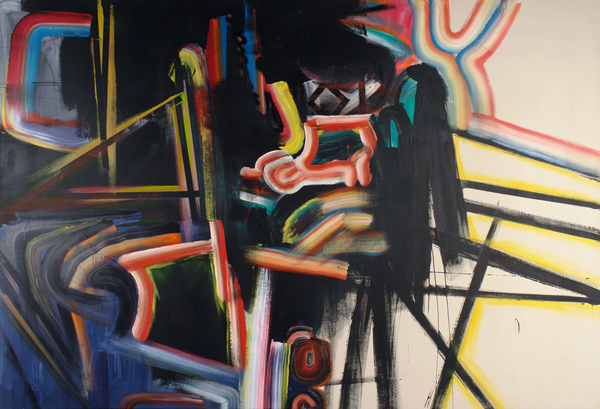 I'm glad writing that's over. It's so hard to write about something I simply have no opinion on. It's much easier to get to work like Wendy White's show at Sixtyseven, which was quite simply bad. No, I don't know why I went to see it. I must've been out of my mind when I planned my trip. The paintings on the wall look exactly like the paintings do online, only larger. Which is to say, muddy, slapdash, uninteresting, and uninspired. I'm amazed that anyone can get oil paints -- which are, after all, beautiful in and of themselves -- to look this unattractive. I think Wendy might actually be angry at the pigments.
I'm glad writing that's over. It's so hard to write about something I simply have no opinion on. It's much easier to get to work like Wendy White's show at Sixtyseven, which was quite simply bad. No, I don't know why I went to see it. I must've been out of my mind when I planned my trip. The paintings on the wall look exactly like the paintings do online, only larger. Which is to say, muddy, slapdash, uninteresting, and uninspired. I'm amazed that anyone can get oil paints -- which are, after all, beautiful in and of themselves -- to look this unattractive. I think Wendy might actually be angry at the pigments.
After that I went downstairs, where I found Jade Townsend's "site-specific installation" at Priska C. Jushka. Perhaps I'm wrong about the meaning of the words "site-specific installation" which appear on the show's promotional literature. My definition of this term is art which is built in a particular place involving the artist's response to that particular place. In other words, it's art which cannot simply be taken apart and rebuilt somewhere else. Something that could be moved would qualify as an installation, but not a site-specific installation.
However, there's nothing I could discern to mark this installation as site-specific. The construct didn't seem to have any relation at all to its surroundings, other than being obviously hard to remove. I don't have photos of the installation because I didn't take any and the ones on the gallery Website don't really tell you much. Here's what I saw as I came into the main room of the gallery: The room has been mostly filled with an old cinderblock wall. There's a hole in the wall big enough to step through, and inside there's a small room with white furniture in it. As you walk around the outside of the installation, you find the other three sides of the area are fenced off with chainlink topped with razorwire. Inside is a small yard of slowly drying grass. Around the other side are some barrels filled with junk, including a small hand axe painted solid black with the word "unlearn" written on it.
At this point you've come back to the hole in the wall in the front. Stepping inside you find some furniture painted white, some knick-knacks painted black, some glow-in-the-dark stuff in bottles, and a view out a small window which is supposed to be a convincing forced-perspective view of a small yard but which is, in fact, so poorly constructed that it looks like a cheap model.
I'll say this: The cinderblock wall was convincing in a stagey kind of way. I can imagine, if I were in an audience, I'd have believed that cinderblock wall had been weathering for years. Put Jesse L. Martin in front of it singing about rubbers and I'd have bought it. I wouldn't have liked it, but I'd have bought it.
And now I must confess: I've always been fascinated by razorwire. Growing up in and around some less than stellar neighborhoods, I'm familiar with seeing razorwire, but I'd never gotten very close to it. I had the kind of childhood where I'd see razorwire, but not the kind where I'd actually touch it. I've always wondered exactly how sharp it is. So there I was, right up next to the razorwire in Jade's work of art. And I touched it. Yes, he broke me -- I touched a work of art in a gallery in Chelsea. Without even thinking about it. I touched the razorwire. It was not very sharp, but I can see how it'd slow you down if you were hopping a fence. Then I realized what I'd done and looked around sheepishly. No one noticed.
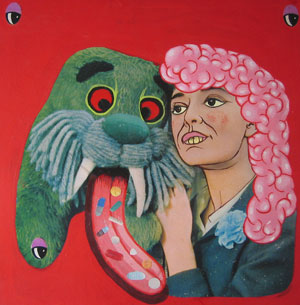 In the hopes that my taking the stairs wouldn't be a complete waste, I dropped in on an opening which caught my eye: Mike Geary's Brainbow at PH Gallery. Mike's paintings are sufficiently weird to make me take a second look: He's got an entertaining sense of the cartoony and his subjects are generally weird. That said, they're just another entry in the long list of Juxtapoz-style paintings. Gee whiz, wacky cartoons in a darkly twisted world of ambivalence and scatology! Oh, baby, transcend my boundaries! I'll be taking a nap over here next to the Caravaggio.
In the hopes that my taking the stairs wouldn't be a complete waste, I dropped in on an opening which caught my eye: Mike Geary's Brainbow at PH Gallery. Mike's paintings are sufficiently weird to make me take a second look: He's got an entertaining sense of the cartoony and his subjects are generally weird. That said, they're just another entry in the long list of Juxtapoz-style paintings. Gee whiz, wacky cartoons in a darkly twisted world of ambivalence and scatology! Oh, baby, transcend my boundaries! I'll be taking a nap over here next to the Caravaggio.
Finally I wound my way back to the last two galleries on my list. The first I'll be calling Ed Winkleman's gallery from now on, because if I just call it Winkleman, or even Winkleman Plus Ultra, I'll feel funny, like I've gone back in time to one of those old British boarding schools where everyone calls each other by their surname. "Tally ho, Winkleman, there's a jolly chap!" Next I'll be calling Ed "Winky" and slapping him on the back while we toss back brandy and smoke cigars. I do not think so.
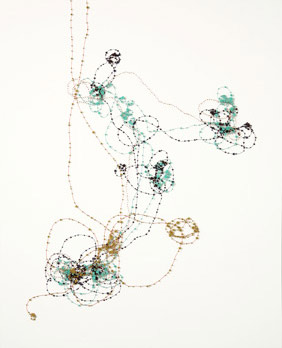 The second gallery was, naturally, Schroeder Romero, right next door to Ed's. Lisa and Mary Jo are showing Janice Caswell's Lay of the Land. Once again I find myself with nothing to say, really. Janice's works consist of lines drawn on paper and then stuck with pins and beads and things, with all sorts of colors and shapes and so on. I have no context for evaluating this. It doesn't look bad. It doesn't look good. It just is. About the only thing I can comment on is the lines themselves -- I consider myself pretty good with lines -- and I wish Janice's lines were more elegant. They seem a little scribbly; they're perfectly rendered lines, they're just meandering. Maybe if they were more confident -- still abstract, but confident -- I'd like them more. I don't know.
The second gallery was, naturally, Schroeder Romero, right next door to Ed's. Lisa and Mary Jo are showing Janice Caswell's Lay of the Land. Once again I find myself with nothing to say, really. Janice's works consist of lines drawn on paper and then stuck with pins and beads and things, with all sorts of colors and shapes and so on. I have no context for evaluating this. It doesn't look bad. It doesn't look good. It just is. About the only thing I can comment on is the lines themselves -- I consider myself pretty good with lines -- and I wish Janice's lines were more elegant. They seem a little scribbly; they're perfectly rendered lines, they're just meandering. Maybe if they were more confident -- still abstract, but confident -- I'd like them more. I don't know.
I'm starting to feel I have this enormous blind spot when it comes to women working with what are traditionally craft media. Sewing, pins, folded paper. I just don't get it. At the moment I'm willing to assume it's my fault. I'll let you know if I change my mind.
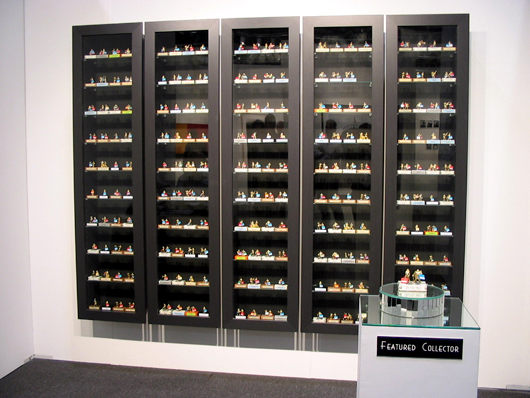 And then there was Ed's gallery. I'm pained to write this. I like Ed, and he's been very nice to me, and I respect him, even if we don't always agree. I want Ed to succeed. I wish him all the happiness in the world.
And then there was Ed's gallery. I'm pained to write this. I like Ed, and he's been very nice to me, and I respect him, even if we don't always agree. I want Ed to succeed. I wish him all the happiness in the world.
But the current show at his gallery, Jennifer Dalton's Would You Rather Be a Loser or a Pig?, struck me as fairly lame. Not too long ago Ed started a long discussion on his blog regarding gender inequity in the art world. Of course this is the raison d'être for blogs like Edna's, this disparity between the obvious fifty-fifty split between the men and women of the world and how many of them get to be professional artists. There's a long, convoluted, disastrous discussion we could have on this topic, but setting that aside for now, let's ask: How do we address this perception? That is, how should we, as artists and gallerists, deal with, and treat in our work, the idea that women are not treated as well as men in the art world? Well, that's what Ed asked, and I think Jennifer's show is part of his answer to that, or anyway part of his trying to find some kind of answer to it.
And I would argue it's a terrible answer. Jennifer's show is didactic and simplistic, not to mention just not very interesting. She even has a PowerPoint slide presentation showing graphs and charts to explain how, for example, having children can hurt your art career, but only if you're female. Okay, the slides weren't made with PowerPoint -- I think she drew them by hand -- but they're just as exciting as any boardroom presentation or college lecture. Another piece of the installation is a few forlorn-seeming pieces of construction paper hanging from the ceiling telling us about how many MFAs are granted to women compared to how many openings there were for women artists in Chelsea last year. Or something like that.
The most interesting thing in the show -- really, the only part of the show that actually is a show -- is a huge display cabinet of little figures of art world people, like they're collectibles. It's called The Collector-ibles. Get it? Get it? Yeah, we get it. Too bad the figurines aren't nearly as well made as those you can find in any Games Workshop store. In fact I suspect the Warhammer geeks would laugh you out of the convention if you showed up with figurines as crude as these. "But that's not the point!" you cry. Maybe not. Maybe I'm being purposely dense. I can't tell.
The other mildly interesting fillip is a pair of bins filled with little plastic bracelets you can take. A sign exhorts you to choose: Do you want to be a LOSER or a PIG? I chose LOSER because I'm realistic, although I suppose I'm a pig in some sense, too. The bracelet barely made it around my wrist, which shows, I guess, that while it's bad to discriminate against women, it's okay to discriminate against fat people.
I'm kidding. The bracelets are made by a company, not by Jennifer herself, and I don't think she meant to make them so they wouldn't fit anyone with a BMI over 42.5. But then I doubt very much that all the gallerists in Chelsea got together to secretly swear only to show fifteen percent women artists.
I imagine there were some other parts to the show, too, but I'd gotten pretty annoyed and tired by then. I really only can tell you about The Collector-ibles because the details are on the Web. When I was there I skimmed past them pretty quickly. I might go back, but only if I'm in the mood to be lectured and hectored. I could just as easily stay home and have my wife yell at me for not doing the dishes.
So that was Super Thursday. Well, it certainly was Thursday, anyway. I was so cranky I didn't say hello when I saw a guy who looked like Jeff Moore. I was so cranky I didn't say hello to Sloth. I was so cranky, in fact, that I didn't speak to anyone, except very briefly. Truly, I am Cranky Man.


Geez, you weren't kidding when you said you were cranky that night!None of the work you've shown particularly appeals to me either, but then I am a pretty representational kind of girl. Wait, I do think the piece by Janice Caswell's piece looks interesting. But I have a thing about small crafty items like beads.
Generally I like craft stuff. I like boxes of beads and colorful things. I always look at things like that and think, wow, if only I could do something with that.But seeing someone actually do something with that, apparently it doesn't click with me.We'll see how tonight goes. See if I'm still cranky.
Hey what do expect from the art mall of America.I hate to paraphrase Charlie Finch, but most art sucks.The still life work was insiped and lame to me, it was painted with to much ironry, and its so dry dry that I gt thirsty looking at them.Isca Greenfield-Sanders: I checked the work out online as well and its not even worth a comment as the work insults my intelligence.The question is Cris, she is being encoureged by her gallery and whoever buys this crap.I live in Boston and you see the same lamo art here and that's the reason I don't go to these events as its more about making a scene than art.I bet if you asked half the people who go to these things ifthey are really looking at the stuff, I mean really there to look and try to from an opinion most would say they are there for the social aspect of it and being part of the scene.Its what I call the emperors new clothes syndrome, people don't want to admit that what they are looking at is for the most part is;1: Real lame.2: Crap.3: Badly executed.4: Just awful.5: Insulting to ones intelligence.
Personally I hate "the scene". Whatever "the scene" my refer to, I hate it, whether you mean "the art scene" or "the music scene" or anything else. I am entirely opposed to the whole concept of "the scene" because I am an outcast. It's partly my nature and partly my choice; I'm not sure it's a virtue (a trenchant friend of mine once told me I tend to make my preferences into virtues) but it is who I am. Also, I don't think any "scene" would have me. (It's a good idea, if you're never going to be accepted, to believe being accepted is a bad thing.)That said, Chelsea is very small but it is also very big. There were probably a hundred openings in Chelsea alone on Super Thursday -- maybe more -- and that discounts anywhere else in the city. All told, there was a tremendous amount of material on display as art that evening. And I saw just a tiny fraction of it, chosen from a slightly larger fraction of online images.I therefore cannot say it was all real lame, crap, badly executed, just awful, and insulting to one's intelligence. The Law of Averages alone says that at least a little bit of it must have been okay. Maybe.And, try to deny it as we might, we have to admit that art is a social activity. There is, by definition, some element of "scene" to all art. You can't hide your light under a bushel and still call it art. As Bucky Fuller liked to say, existence is plural and at minimum two.So when I'm stuck in "the scene" and annoyed at how bad everything is and considering giving up, I try to remember that there are good things, good people, and good art out there. Somedays it's just really hard to find.
Doug and I had a debate on our way home from the city as to how much of this art in Chelsea actually sells. He thinks it must in order for the galleries to continue to stay open, I am more doubtful. Do you have any idea? Do you see red dots at these openings?Like you, I have never felt comfortable in any type of scene, with the exception of the dive bar/loser scene for awhile in college. Now that I am all cleaned up I don't fit anywhere, which is just as well.
I'm probably not the one to ask about sales. I don't keep much track. At times when I have looked for the Red Dot I've found a surprising number. But that doesn't say much; it's possible, I imagine, that gallerists apply the Red Dot to works which sold before the show, works which are owned by friends of the artist, works the artist doesn't want to part with, and so on. I don't know, but I've got to figure there's some Red Dot inflation at work.In theory enough must sell to keep a gallery open. In fact who knows where the money comes from? Co-operatives are paid for by the members and don't really need sales. I'm sure some galleries are run by rich kids using Daddy's money. Some of them may be run by rich people using their own money.And then there's the question of how many will fail. There never seems to be a shortage of restaurants but we always hear about what a tough business it is. There are always people with money to invest in dumb ideas.Bottom line: I have no idea if this crap sells. All I'm sure of is, I hope not.
It occurs to me, Painterdog, that the story of the Emperor's New Clothes has a flip side which is never explained. The story ignores the simple fact that it is possible to be wrong. It is possible, in reality, for everyone to be laughing at the emperor, thinking he's naked, when he's actually not naked at all; he's just wearing clothes the people don't understand.History is full of revolutions big and small which were dismissed by the general public (to say nothing of the "experts") which are now universally considered to have been very important -- but which went over most people's heads.Of course, worrying about missing the boat leads to what I call the Jazz Effect, where you have to embrace anything shocking and new which comes along just in case it's the modern equivalent of jazz, so in the future you can say you "got" it before anyone else did.I tend to trust myself most of the way; I think I can tell crap from not crap most of the time. But I still have a kernel of self-doubt where I wonder if maybe I'm just missing something. Take Karen Dow's paintings, for example: I've got to be missing something there, don't I? There's some color theory or deep geometric pattern or something she's working with. Right?Just because I can't see it doesn't mean it's not there.
Cris the "Emperor's New Clothes" was ment to be a warning to people to not beleive in all that you are told see.We all know the fable, and its pretty straight foward to me. You can read your own thing into it, and yes its interesting to think maybe the people did not see the right thing, but as the fable went the people did think the Emperor had on beautiful clothes until a small child said that he was naked.I only use this as an alogry to what you posted and what you saw.I have been to the area many times and in general I would say I like about 2% of what is on view.Jazz is not a good thing to compair as 99.9% of jazz musicians pratice a lot and they are steeped in the history and the craft of the music. This includes most of the avant garde musicians of the 60's and 70's.Anyone can say they are an artist and do whatever they want, that's how art is taught now in most art schools.Music is different, you can't even start to play with out at least years of learning your scales and spending time in the "shed".All musicians know this.
Karen Dow's paintings are to much like Mondrian, or should I say derivative of his work.He did it first, and he did it better.There are painters doing things with this kind of grid, Torben Giehler is doing some interesting things with it.I'm not into it but at least he's doing something with the idea instead of using a different palette. From what I can see not a very good one at that.So I think your right about your comments.
After looking at Karen Dow's work I think I have to say that I may like it, at least virtually. I don't know what her intent is as I didn't see a statement on her site, but I don't think I really care anyway. I like her sense of color and I see what I think are doors and other architectural elements which intrigues me because the pieces seem so abstract at first. Plus I am a sucker for olive green and Kmart blue which she seems to use a lot.
The Mondrian template that her work uses does not bother you?I like olive green to but using it in a painting does not make it a good painting.You can do a great painting on gray tones.Each to there own.
I think it's important here, Painterdog, to admit to ignorance. For me, anyway. I've seen some of Mondrian's work, but not a huge amount -- there was a show a few years back at MoMA, I think -- and I really lack any knowledge of how his work influenced later painting. For all I know, Karen Dow's work is the latest in a long line of incremental developments and deviations from Mondrian's experiments, just as I'm sure Mondrian has his antecedents (of whom I am similarly ignorant).So I'm unwilling to dismiss Karen's work that quickly. There may be valid and complex theoretical underpinnings to her paintings which I'm simply unaware of.For example, just looking at an Albers painting, I think, well, this is pretty boring and worthless. However, in the context of Albers' explorations and experiments in comparing and contrasting colors, his paintings have meaning. They're still not my favorites from a purely aesthetic point of view -- which of course is the most important to me -- but I can't just dismiss Albers' paintings entirely.Also, in person her paintings are less derivative of Mondrian. When I think of Mondrian what I think of is large fields of barely modulated colors -- white next to a slightly greyer white -- with small stripes or bursts of more intense color, often with strong brushstrokes and textures. Karen's paintings, in contrast, are less linear and use more rectangles; and her fields are flat and nearly featureless. That makes them less interesting to me, actually: Mondrian's paintings are greatly enlivened by the textures and slight color changes, which reproduce really poorly, if at all.Still, Karen may be doing something more than I can see. Maybe I'll ask her if I see her or can find an e-mail address.
the gray white is from the paint discoloring due to age, and his medium.I personaly find this kind of painting a bit boring. Hey lets use the grid to create a painting...Albers color theory book is used in teaching all over the place. ITs interesting, my wife uses it, it gives students a grounding in color theory, which is good. His paintings are just examples of his ideas, no more no less.They are interesting in that they show how colors and hues react to eachother.Its used a lot and to many people get caught up in it.Check out William Bailey's still life work. You should check out all his work.I think you will find it inrteresting.
Painterdog sez:the gray white is from the paint discoloring due to age, and his medium.Maybe. It looked intentional to me, because the various shades varied across the canvas in a rectilinear fashion. Maybe Mondrian did intend them all to be the same color but did different areas at different times, so the different mixtures have aged differently.At the show I saw, they had Mondrian's last painting, which was unfinished. It still had the masking tape stuck to it. The masking tape -- which is hardly archival -- was in pretty good shape, as I recall. So I can't imagine his oil paints have aged that much.But it's possible, I guess.I personaly find this kind of painting a bit boring. Hey lets use the grid to create a painting...In at least one Mondrian -- you can never see this in the reproduction -- each band of color has tiny, wavering brushstrokes all the way down. Like sand ripples in the desert. So Mondrian is not all about the grid, man.
Sorry, I did not mean Mondrian, I like his work, and his early work is reperesentational and very good.I meant work like Karen Dow's.There are several factors in the aging of paint. The quality of the pigment and oils used,it could be dirt from just hanging on a wall for 60 years.His work is about grids and color relationships.The semi-transparent brush stroke you describe is more about paint quility.The grids seem to be the basic structure his work after he stopped doing landscapes and such. In some ways he still was doing landscapes.Sorry for the misunderstanding, I like Mondrian's work, I was just commenting on how a lot of painters have gone off on his approach, which shows how good he was as he is still influenceing people.
Painterdog, I didn't say Karen Dow's work was good, I don't really feel qualified to make that kind of judgement. I said that I think, based on the computer images, that I like it. I like the colors, I like the grids and I like the architectural elements that I see. When I looked at her work I wasn't really connecting them to Mondrian's grids, to me they just have a whole different thing going on.Even though I have a tendency to like grids, I have never really liked Mondrian's very much. I especially do not like the later ones. I appreciate them but he's really not a painter whose work "gets" me.
I think you are qualified to make that kind of judgement. It's Ok to form an opinion. Have you seen Torben Giehler's work?He uses grids and they have this kind of landscape thing going on.I like grids myself, I just think there are ways of using them that can be more interesting.I'm a representational painter so I use perspective grids and the sometimes the golden mean golden mean which a kind of grid.to be fair to Karne's work I should see it in person, the more I think about it its not really fair to judge work like this on a monitor.I like his early work better myself.
Chris how come you don't take some painting classes?If you ever want to check out the Art Students League, as its cheap and there are some very good teachers there.
It's Ok to form an opinionI did form an opinion. My opinion is that I think I may like her work, based on what I have seen virtually. I am not willing to say it is good, because good is a ridiculously subjective adjective when it comes to art. I find Karen Dow's work to be much more appealing than Giehler's. Certainly though, if I were to see these works in person I might have a different opinion.
I find that Torben Giehler is younger than I am, therefore I despise him. It's no fair.Seriously, those paintings look realy good.As far as taking some painting classes: Some days I feel like I really need some straight academic painting skills. Some days I feel I never want to take a class in art. Today is one of the latter. Today I say, art classes? Who needs 'em?
ahh to procastinate...leanring new things is good. control over the medium is also a good thing.you might get to where you want to go faster, then again you might not.all I know is that the more I studied the better I became, the more freedom I had to paint what I was thinking about.
hes younger and richer...I went to school with him, so think how I feel.
An old friend of mine was nominated for an Oscar last year, so I have an inkling.I know what you're saying about learning to paint. Like I said, some days I agree with you, that learning more would give me more freedom. I could use technique. On the other hand, I'm absolutely terrible at school. I hate being taught. I'm an autodidact all the way. It can take longer, maybe, but it's how my brain is wired.But I know what you mean. I may still give it a shot.
chris -i'm depressed too.you're not alone.
That grid thing at Yale came when Mel Bochner took over. That dude gets a chubby over anything with squares.
You mean a woody...Grids can kill you.
So, based on your "My Guernica" comment, you don't believe in the re-interpretation of songs, stories, and myths?
Tofu-powered Nicole asks:So, based on your "My Guernica" comment, you don't believe in the re-interpretation of songs, stories, and myths?Not exactly. It's hard to pinpoint where I stand on reinterpretation. It depends on when you catch me and, of course, on the specific item we're discussing.On the one hand, I believe strongly in originality, in the power of the new idea. I disagree strongly with anyone who claims that there's no such thing as an original thought. I think our world is populated by original thoughts.That said, I also realize that original thoughts never emerge spontaneously. They're grown in a rich loam of influences, past ideas, and modern objects.So I can't say I'm against reinterpretation. However, I think many times the claim of reinterpretation is made in defense of intellectual laziness. Someone can't think of anything original, so they give up and say they're "reimagining."So for that reason, I'd say I am against reinterpretation: Because I don't want to give anyone that escape hatch. I'd rather argue that no one should do it than argue that lots of people should give it a try, even if almost all of them will fail. You may survive a jump off the Golden Gate Bridge; that doesn't mean you should do it.
To make a note regarding sales, which discussion was up a few comments:I'll be writing up my most recent visit to Chelsea soon, real soon, I hope soon. Soon. Really. While I was there I picked up the little sales sheet for Mary Henderson's show at Lyons Wier • Ortt. Mary has 13 paintings in the show, none larger than 14 by 11 inches. Three gouaches, each about 8 by 6 inches, are listed on the sheet for $2800 each. All ten other pieces are sold.I'd assume oils go for more than gouaches -- although in this case, having seen both, I'd pay more for a gouache because, damn, gouache is hard to work with and Mary is a virtuoso -- but, assuming $2800 per piece, that's $28000. I'd say the gallery made their rent for the month.Lyons Wier • Ortt is cool because they always give out a sheet like this at the gallery. Other galleries are not as forward. Perhaps it's considered gauche to discuss money. I don't know.